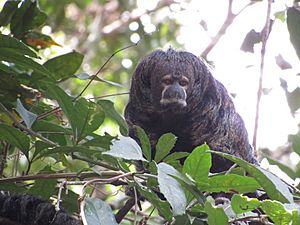Miller's saki facts for kids
Quick facts for kids Miller's saki |
|
|---|---|
 |
|
| Conservation status | |
| Scientific classification | |
| Genus: |
Pithecia
|
| Species: |
milleri
|
The Miller's saki (Pithecia milleri) is a special kind of monkey. It is also called Miller's monk saki. This monkey is a type of saki monkey, which belongs to a group called New World monkeys. These monkeys live in the forests of South America. You can find them in parts of southwestern Colombia and northeastern Ecuador. They might also live in nearby areas of Peru.
Miller's sakis are known for their interesting fur. Male and female sakis have different colors, which is quite unique!
Contents
Discovering Miller's Saki
Scientists have been studying Miller's saki for a long time. The first person to describe this species was a scientist named J. A. Allen in 1914.
For a while, some scientists thought Miller's saki was just a type of another saki monkey called the monk saki. This happened in 1987. But then, in 2014, after more research, scientists decided that Miller's saki was its own full species again. This shows how science keeps learning new things!
What Miller's Sakis Look Like
Miller's sakis have fur that helps them blend into their forest homes. They are medium-sized monkeys with long, bushy tails.
Male and Female Differences
One cool thing about Miller's sakis is that males and females look different. This is called sexual dimorphism.
- Female sakis often have more grayish fur on their faces and bodies.
- Male sakis are usually darker. Their fur is a grizzled black, which means it looks like a mix of black and gray. They also have brown fur on their faces and forearms.
This difference in color helps scientists tell them apart in the wild.
Where Miller's Sakis Live
Miller's sakis are found in the northern parts of South America. Their home includes:
- Southwestern Colombia
- Northeastern Ecuador
- Possibly some areas in Peru that are close to Colombia and Ecuador.
They live in the dense rainforests, spending most of their time high up in the trees. These monkeys are very good at moving through the branches.
Images for kids



